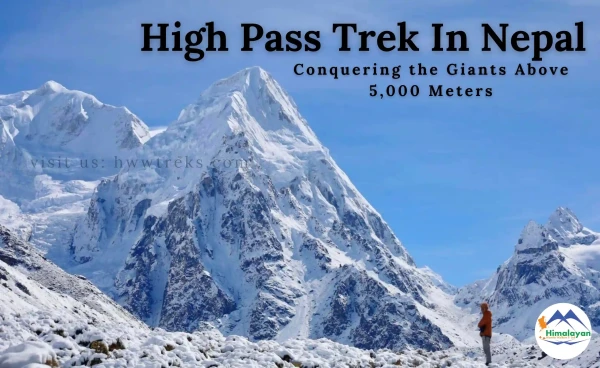- 12/13/2024
- Himalayan Wander Walkers
Nepal Peak Climbing Gear and Equipment
Climbing Gears play a vital role in mountaineering fields. While you are planning to climb peaks in Nepal, you might be in confusion what to bring and what not to? So, Himalayan Wander Walkers have prepared this checklist of Peak Climbing Gear and Equipment with the help of our experienced climbing guides and field staff.
In General, any mountain with a maximum elevation below 7000 meters is considered as a Peak in the Nepal Mountaineering industry and beyond 7000 meters are known for the Mountains. Trekking Peaks are also classified into two kinds they are Nepal Mountaineering Association (NMA) Peaks and Free Peaks. NMA peaks required royalties for permits whereas Free Peaks can be climbed without permits.
It is essential that every peak climbing require technical skills, enough Gear and equipment, and an experienced expedition team to achieve your dream to summit your desired Peaks in Nepal. We arrange an expert and professional team of guides, porters, kitchen helpers, and a Sherpa team leader.
Contents [hide]
Peak Climbing Gear and Equipment costs can be cut down
Do you know Gear costs for peak climbing can be cut in many ways? Most of the trekkers, hikers, and climbers don’t want to spend much money on gear because besides it they need to pay for other costs such as food, accommodation, transportation, and crew members. These days you can find a lot of mountain gear brands in the market but you must know what to buy and what not to? Below you will find some secret tips for saving your cost on gear and equipment.
- Rent Gear and Equipment
Gear and equipment rental shops are available in Thamel, Kathmandu. It is a great way to check your size before purchasing them. Renting gear will save your cost because most of the good-quality gears are expensive. - Borrow Gear from Friends
If you have a good friend circle who are engaged in trekking and mountaineering field then it is the right time to ask for help from them by borrowing their gear. This will be the best option to save more on gear without paying a single penny. - Buy Second Hand
There are trekkers and mountaineers who had made a trip to the mountain once but have used gear and equipment which are expensive. They don’t want to just give away instead they are willing to sell them at a lower price. - Become a brand ambassador
These days there are many influencers who had great profiles on social media like Facebook, Instagram, and youtube. If you own a good social media profile then this is a good opportunity to deal with some branded gear companies as Brand ambassadors. Being a brand ambassador not only gets free gear but some even earn commissions in addition.
Tips for Peak Climbing
- Check Gear Size
- Bring your own Climbing Boots
- Do regular training before starting your Peak Climbing Trip
- Do research or study the trip details
Gear and Equipment Checklist for Peak Climbing in Nepal
1. Clothing
- Thermal Base Layers – Tops and Bottoms
- Heavy Base Layers
- Trekking Pants
- Hard-shell Goretex pant for summit day
- Down Pant evening at tea house and camp
- T-shirts – Short and long sleeve
- Mid Layer Top
- Insulated Jacket
- Hard-shell Goretex jacket for summit day
- Down Jacket/Parka for Evening and Morning
2. Footwear
- Double insulated mountaineering boots for climbing (Any alpine shoes will be accepted but I recommend the g2sm model from La Sportiva)
- Hiking/Trekking shoes (Full and waterproof)
- Lightweight shoes for camp and around town
- Gaiters to save your shoes from Snow
- Flip-flops
- Wool/Synthetic socks
- Liner socks
3. Handwear
- Liner gloves
- Mid-weight gloves
- Down mittens
4. Headwear
- Cap/Sun Hat
- Pullover hat
- Balaclava to keep your neck warm
- Warm wool/Synthetic Hat
- Eye Wear (Full coverage around eyes and nose)
- Ski Goggles
5. Climbing Gears
- Helmet
- Waist leash
- Mountaineering Crampons
- Lightweight Mountaineering Harness
- Carabineers
- Belay Device(ATC Guide or Figure 8)
- Ascender/Jumar
- Prussik /Accessory Cord
6. Accessories
- Water Bottles: 2 bottles of 1 liter each with insulation cover or portable Thermos
- Trekking poles
- Headlamp: 200-300 lumens with spare batteries
- Camera
- Power bank/Solar Charger
- Universal adapter
- Notebooks/Diary
- Pocket knife
7. Hygiene and first aid
- Skincare (Maximum SPF sunscreen and lip balm)
- Toothbrush, Toothpaste, Soap, Moisturizer
- Hand Sanitizer
- Toilet paper and wet wipes
- Personal first aid kit (Include personal prescriptions, high altitude medications, painkillers, first-aid tape, band-aids, etc.)
- Water treatment
8. Others
- Comfort Foods (Bring snacks and foods you like to munch)
- Travel clothes to wear in Kathmandu
- Sleeping bag (-20 degrees sleeping bag)
- Inflatable mattress - lightweight (Option)
Conclusion
Come and join the HWW team to achieve your dream to summit your desired mountain which offers you the remarkable and worthwhile life experience of immaculate snowy peaks, ancient and isolated villages, high passes, and splendid vistas.



